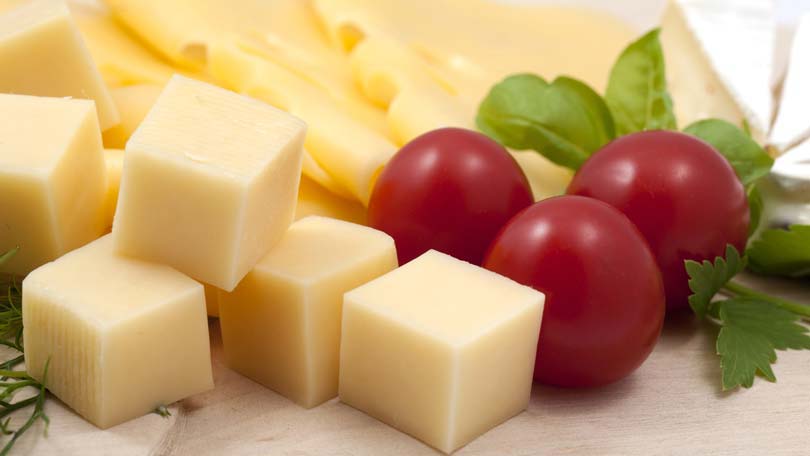
Gouda is a yellowish Dutch cheese named after the city of Gouda, but the term Gouda is now a generic name, and not restricted to cheese of Dutch origin. Without any spices added, this cheese has a mild, creamy taste that has not changed since the Gouda cheese was first made several centuries ago.
Gouda is made from cow’s milk that is cultured and heated until the curds separate from the whey. About ten percent of the mixture is curds that are pressed into circular molds for a couple of hours. The round molds give the cheese its traditional wheel-like shape. After that, it is soaked in a brine solution, which gives the cheese its rind and improves the taste. After the salt soaks in, the cheese is then dried for a couple of days then it is coated with a red or yellow paraffin wax to prevent it from drying out. The large wheels of cheese usually weigh between 10 and 25 pounds and can be aged anywhere from a few weeks to over a year. When aged over a year, it takes on almost a cheddar-like flavor.
Although Gouda is Holland’s most famous exported cheese, it is now produced in many other countries around the world, generally by the same methods, although in some countries government regulations prohibit the use of raw milk. Gouda from Australia, New Zealand, Israel, and Brazil, as well as Sweden, Norway, and other European countries can be found in many cheese markets, mega-marts, and health food stores. Gouda can be made from whole or part-skim cow’s milk and comes in a smoked variety. Due to its higher fat content, it is considerably creamier than other common cheeses, such as cheddar cheese or Edam cheese.
Traditional Dutch Gouda, with its intense flavor, is appropriate for shredding and grating. It is aged for 18 months and coated in black wax, which offers a sharp visual contrast to the orange cheese. Specialty Goudas may have cracked pepper, garlic, and onions, caraway or cumin seed, or nettles and other fresh herbs mixed into the curd. Aged Gouda that has been cured for two years is a more rare product, and one prized by cheese experts, but keep in mind, the younger the Gouda, the milder the flavor.
History
For centuries, farmers from the surrounding towns have brought their produce to the cheese market in Gouda. The “Waag” (weigh house) in Gouda is one of many beautiful monuments in town and dates from 1668. During the summer, cheese is weighed here every Thursday morning in a ceremony that draws many tourists. Anyone interested or hungry can also take the opportunity to taste some authentic Gouda cheese.
The old weigh house of Gouda is also a cheese museum now. The Dutch dairy-industry and the city of Gouda are placed in the framework of cultural history, economy, architecture, society, agriculture, trade, and industry by means of visual displays and modern interactive media devices.
Baby Gouda
Baby Gouda comes in rounds weighing no more than a pound and usually has a red wax coating. Some Goudas are flavored with cumin or herbs. Though Gouda is extremely mild-flavored, it is particularly good with beer, red wines, and dark bread. The Dutch make a dish called kaasdoop, which is a Gouda fondue served with potatoes and rye bread.
Goat’s milk Gouda
This type, also made in Holland, resembles traditional Gouda in texture and physical appearance, but has a tangier flavor.
American Gouda
Mass-produced in Wisconsin and New York State, this cheese is very similar to the Dutch original. It is available in wheels weighing less than a pound. Today, a number of skilled American artisans also produce unusual and highly prized Gouda cheese.
Goudas Nutritional Highlights
Gouda cheese, 1 slice 1 oz. (28g)
Calories: 101
Protein: 7.0g
Carbohydrate: 0.63g
Total Fat: 7.8g
Fiber: 0.0g
Buying and storing tips
Semi soft Gouda is typically stable for about a month. Unopened Gouda packaged in paraffin can be kept safely for approximately a year when refrigerated.
Preparation, uses, and tips
Gouda is good as a table cheese and for snacks and grilling. Aged Gouda can be grated over baked potatoes or included in potatoes au gratin. It goes particularly well with good bread and any type of wine or beer. Gouda is a breakfast staple in Europe, eaten with fresh fruit.
Serving Suggestions
This mild nutty creamy cheese with a piquant aroma also works well as a substitute for cheddar in macaroni and cheese recipes. The Dutch make a Gouda fondue with this cheese. Since this cheese is great for eating with crackers and fruit and a glass of Chardonnay to wash it down, it just might be the perfect cheese for entertaining friends and family.
